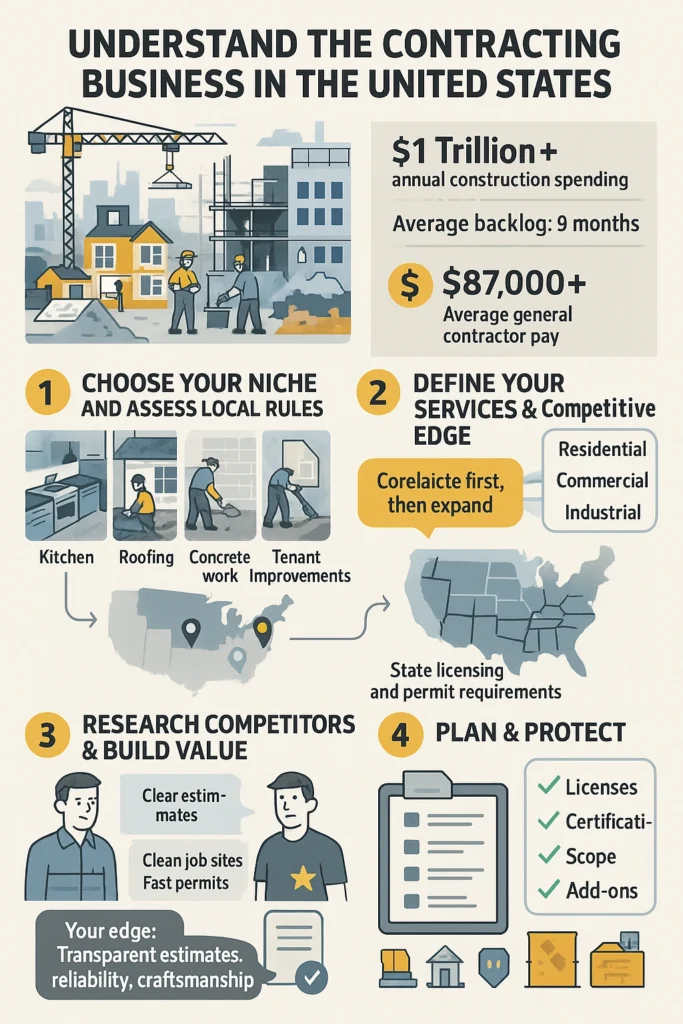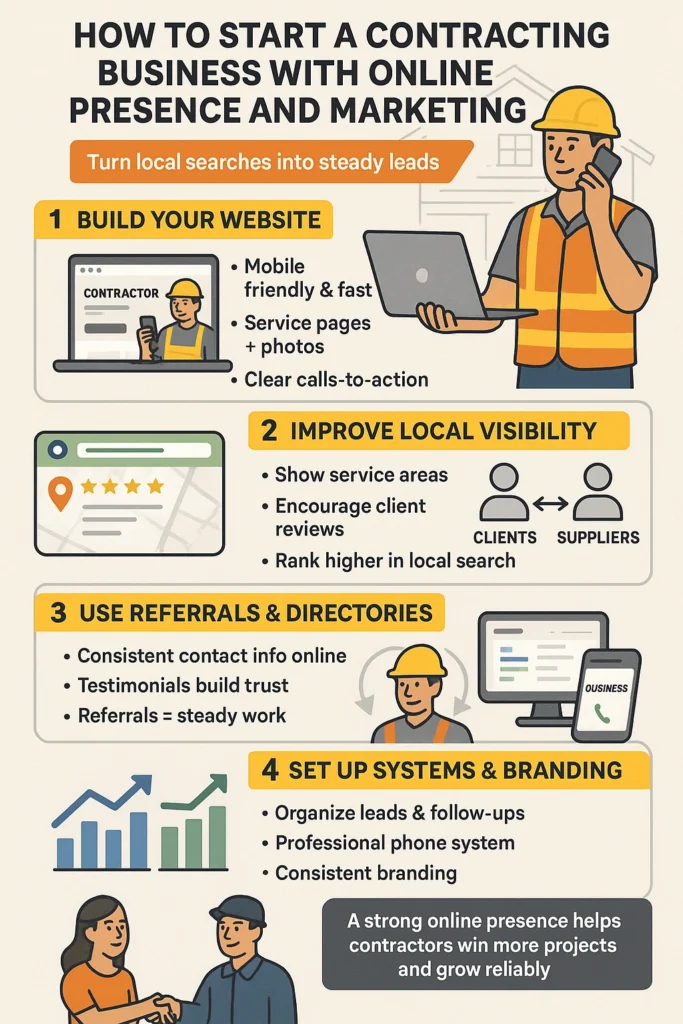To start a contracting business, begin by defining a clear niche such as general contracting, remodeling, or specialty services. Register your business name, obtain an EIN, and meet state licensing requirements. Insurance is essential from day one to protect projects and qualify for permits. Next, open a business bank account to separate finances, build a lean plan with startup costs and tools, and set clear pricing for your services. Finally, launch your online presence with a professional website, Google Business Profile, and reviews so clients can find and trust you.
Key Takeaways
- Market demand is high in U.S. construction; pay and backlog support steady work.
- Pick related trades first and offer a narrow set of services for clarity.
- Register properly, secure insurance, and choose the right business structure early.
- Open a separate account and track cash flow from day one.
- Build a lean plan that prioritizes tools, estimates, and permitting.
- Launch basic marketing and a website to capture local customers and reviews.
Understand the Contracting Business in the United States
The U.S. market shows steady work for skilled trades, with multi-month pipelines and today’s large public and private spending. Average backlogs for many general contractors exceed nine months, and national construction spending tops $1 trillion annually.
That demand translates into real earning power. Indeed reports average pay for a general contractor above $87,000, and revenue grows as you take on larger projects and manage broader scopes.
Choose your niche and assess local rules
Decide if you’ll act as a general contractor coordinating trades or focus on specialty work where your experience can command higher rates. Map your skills against local demand, kitchens, roofing, concrete, or tenant improvements, and match services with any equipment you already own.
Evaluate your local state timelines for permits, licensing categories, and supply availability. Those factors affect pricing, schedules, and how competitive your business will be.
- Consider service areas and typical project sizes; travel and crew logistics add cost.
- Identify suppliers, subcontractors, and inspectors early; people shape on-site success.
- Study competitors to find a clear edge, faster turnaround, specialized permitting, or superior craftsmanship.
Define Your Services and Competitive Edge
Master a couple of related trades that match your gear and experience. This focus helps you control costs and deliver consistent workmanship.
Pick related trades before expanding
Choose two or three trades where your current equipment and skills shine. Specializing, carpentry with painting, for example, builds reputation faster. Work for established contractors first if you can; that experience sharpens estimating and on-site workflow.
Target customers: residential, commercial, or industrial
Define which customers you’ll serve: homeowners, property managers, small businesses, or industrial clients. Tailor estimates, timelines, and communication to how those buyers judge a contractor.
Research competitors and craft your value proposition
Study competitor portfolios and reviews to find gaps. Then state clear advantages such as transparent estimates, clean job sites, and faster permits. Add proof points, before/after photos and references, that cut perceived risk and win projects.
- Map services to project budgets you can finish reliably.
- List required licenses and any certifications that add credibility.
- Outline liability limits and scope boundaries in quotes.
- Plan productized add-ons for recurring revenue.

Build a Practical Business Plan
A concise plan that maps services, costs, and revenue clears the path from concept to profit. Your plan should name your location, outline required investment, and set an operating budget. Include working capital needs and a clear roadmap to profitability.
Estimate startup costs realistically. For general contractors, plan on roughly $15,000–$20,000 depending on tools, equipment, and staffing. Stage purchases so essentials that generate revenue come first.
- Document services, target market, and estimated costs so lenders and partners can trust your assumptions.
- Forecast month-by-month cash flow to cover deposits, materials, and payroll ahead of progress payments.
- Add pricing models, job-cost templates, and assumptions about project size and close rates for accurate projections.
- Write a marketing plan covering website, local SEO, reviews, and referrals to sustain lead flow.
- Choose a business structure early since it affects tax, liability, and investor conversations.
| Plan Item | Typical Detail | Why it Matters |
| Startup Costs | $15,000–$20,000 (tools, licenses, insurance, marketing) | Sets initial funding and staging for purchases |
| Ongoing Costs | Materials, subcontractors, repairs, advertising | Drives monthly cash flow needs |
| Key Information | Supplier terms, sub rates, insurance certificates | Speeds estimating and job setup |
| Milestones | First 10 projects, first hire, $100k revenue | Measures progress and prompts plan updates |
Choose a Business Structure and Register Properly
Choose a legal setup that protects your assets and fits your growth plan. Registering lists your company with state and federal agencies and sets rules for taxes, liability, and recordkeeping.
Compare sole proprietorship, LLC, and corporation for differences in liability and business tax treatment. A sole proprietorship is simple but offers minimal liability protection. An LLC limits personal exposure and keeps flexible pass-through taxation. A C or S corporation adds formality and potential tax benefits for some owners.
- Verify name availability, register your company with the state, and get an EIN from the IRS so you can open an account and file taxes.
- Match registration details, name, address, and ownership, across filings, permits, licenses, and insurance to avoid delays.
- Consider state fees, publication rules, and reporting requirements since they vary by location.
- Plan for future changes; you can convert your structure as revenues grow or partners join.
Open a dedicated account and start bookkeeping right after registration. Clear financial separation protects personal assets, simplifies filings, and supports permits and bonding when you bid for larger work.
Licenses, Permits, Bonds, and Compliance
Before you bid on projects, confirm local licensing paths and any bond rules that apply. States and counties set different requirements. Many boards ask for documented industry experience and passing trade, business, or law exams.
Collect exam results, work history, references, and financial records in one folder. Boards often require proof of general liability insurance or specific liability insurance endorsements before issuing approval.
State licensing essentials
Verify whether your trade needs a specialty license (electrical, plumbing, HVAC). Check that your corporation or LLC details match license records. Mismatched names or addresses can lead to administrative rejections and delays.
Surety bonds and permits
Surety bonds protect owners if you fail to meet contract terms. Some public and private projects mandate bonding; the SBA Surety Bond Program can help qualifying firms obtain coverage.
- Confirm local permit and inspection rules; budget time and fees into bids.
- Create a compliance calendar for renewals: licenses, coverage, and bonds.
- Keep insurance certificates, financials, and application documents accessible for audits.
| Requirement | Typical Need | Who Requires It | Why It Matters |
| State license | Experience, exams, fee | State licensing board | Legal permission to perform regulated work |
| General liability insurance | $1M+ typical coverage | Licensing boards, owners | Protects against third-party claims and is often mandatory |
| Surety bond | Bid, performance, payment bonds | Public agencies, some owners | Guarantees contract performance and payment |
| Municipal permits | Building, electrical, plumbing inspections | City or county permitting office | Ensures code compliance and project sign-off |
Protect Your Company with Insurance from Day One
Insurance isn’t optional; it’s the shield that keeps projects, permits, and credit intact. Before you file for licenses, many state boards require proof of active coverage. That makes general liability insurance the first policy you secure.
General liability protects against third-party claims for property damage and bodily injury. Match limits to project size and contract clauses so owners and lenders accept your certificates.
Workers’ comp, commercial property, and BOP
Add workers’ compensation once you hire employees. Commercial property covers tools, trailers, and office gear. A business owner’s policy bundles liability and property for cost savings and simpler renewals.
- Work with a licensed agent who knows contractors and required endorsements.
- Require subcontractors to provide certificates before any site work begins.
- Reassess coverage annually as your services expand or your corporation structure changes.
- Train employees on incident reporting and jobsite safety to keep loss history low.
| Policy | Primary Purpose | When to Buy | Key Notes |
| General liability insurance | Protects against third-party claims | Before licensing and bidding | Adjust limits to match contracts; add additional insured endorsements |
| Workers’ compensation | Covers employee injuries | When you hire employees | State-specific rules; mandatory in most states |
| Commercial property | Protects tools, equipment, and office assets | When you store significant assets | Consider inland marine coverage for tools in transit |
| Business owner’s policy (BOP) | Bundles liability and property | Small teams seeking cost efficiency | Simplifies renewals and can lower premiums |
Tools, Equipment, and Startup Purchases
Prioritize purchases that cut labor hours or unlock higher-paying work. Tools and equipment are among the largest startup costs, so plan buys that generate revenue quickly. Buy essential handhelds first and delay large capital purchases until cash flow stabilizes.
Buy, lease, or refurbish: choosing the right approach
Assess used gear versus leasing for heavy items. Leasing preserves cash and offers upgrades; refurbished purchases lower upfront costs but may need extra insurance coverage and maintenance.
- Inventory must-have tools and equipment for your first projects; buy items that increase productivity.
- Compare monthly lease payments, utilization rates, and long-term ownership costs before signing.
- Confirm insurance coverage for leased or refurbished gear and add endorsements for theft, damage, and on-site liability.
- Consider equipment loans for mission-critical purchases with clear ROI; review rates and maintenance obligations.
- Standardize brands and batteries where possible to cut downtime and simplify service for your company.
- Create a maintenance schedule and tool-tracking procedures to prevent loss across jobs and keep projects on schedule.
| Item | Typical Choice | Why It Matters |
| Handheld tools | Buy new/used | Direct revenue generators; lower long-term costs |
| Heavy equipment | Lease or refurbish | Reduces upfront costs; needs added coverage |
| Specialty tools | Rent as needed | Start lean and expand with bookings |
Pricing Your Work and Estimating Projects
Set clear pricing rules before you bid so margins survive delays and change orders. Establish a baseline and multiply your desired daily earnings by estimated project days, then add materials and permit fees. Include overhead for equipment, insurance, software, and admin so you don’t underprice.
Setting a service rate: labor, materials, overhead, and permitting
Build estimates that combine labor hours with waste factors for materials. Allocate overhead per job so tools, depreciation, and liability coverage are recovered.
Research local permitting costs and timelines. Permits vary by town and county and can change project costs and schedules quickly.
Bid strategy: winning the right projects at healthy margins
Adopt best practices in bidding: qualify leads, clarify scope early, and document exclusions. Offer alternates that protect margin while giving clients options.
- Track win rate; near 100% means raise prices; near 0% means reassess scope or messaging.
- Publish clear service descriptions on your website to set expectations and shorten sales cycles.
- Collect post-project data to compare estimates versus actuals and refine future pricing.
| Pricing Element | Typical Inclusions | Impact on Quote | Quick Action |
| Labor | Hours, wages, payroll tax | Largest variable; drives margin | Track hours by task |
| Materials & Permits | Parts, waste factor, permit fees | Direct cost; can delay schedule | Confirm permit fees before bidding |
| Overhead & Liability | Insurance, equipment, admin | Allocated per job to protect business | Include fixed percentage in each quote |
| Contingency | Change orders, unexpected delays | Preserves margin under risk | State clear change order terms |
Banking, Taxes, and Financial Operations
Open clear financial channels early so client deposits, vendor bills, and payroll stay separate and trackable. A dedicated account signals professionalism, preserves your liability shield, and makes filings simpler. Establish a business credit card and a small line of credit to smooth cash flow between deposits and material purchases.
Implement bookkeeping from day one. Categorize income and expenses consistently so quarterly estimated payments and year-end tax returns are accurate. Use IRS Small Business and Self-Employed Tax Center resources for federal guidance on payroll withholding, deposits, and hiring.
Banking and credit
- Open a business checking account immediately for receipts, payroll, and vendor payments.
- Build business credit with timely card and loan use; lenders look for on-time activity and clear statements.
- Keep banking contacts handy so you can scale working capital when a large project lands.
Taxes and payroll
- Choose payroll software that handles withholdings, state filings, and year-end forms for employees and contractors.
- Collect W-9s, verify insurance certificates, and issue 1099s on time for subcontractors.
- Coordinate with your CPA about deductions, depreciation, and whether your corporation or LLC tax status should change as revenue grows.
| Area | Primary Action | When | Why it Matters |
| Business checking account | Open with EIN and registration | Immediately after registration | Separates funds and supports liability protection |
| Business credit | Apply for card and small line | Once account history begins | Improves purchasing power and credit profile |
| Payroll & taxes | Select software; follow IRS guides | Before first payroll | Ensures correct withholdings and reduces penalties |
| Vendor & subcontractor compliance | Collect W-9s; verify insurance | Before work begins | Protects against misclassification and audit risk |
How to Start a Contracting Business with Online Presence and Marketing
A clear online presence turns local searches into booked projects and steady leads. Build a fast, mobile-friendly website with service pages, project photos, and trust signals so customers decide quickly.
Website and local SEO
Claim and optimize your Google Business Profile. Add photos, service areas, and categories. Ask satisfied clients for reviews that improve local rankings in your state.
Referrals and platforms
List consistent NAP citations across directories. Use Angi and Houzz to showcase completed construction work and gather testimonials. Develop referral loops with suppliers and past clients.
Branding, CRM, and phone systems
Use a CRM like HubSpot to capture leads and automate follow-ups so no estimate slips through. Set up a dedicated phone system and voicemail for a professional touch.
- Website with clear calls and before/after case studies.
- Optimize Google listing and encourage reviews.
- Leverage Angi/Houzz and supplier referrals.
- Implement CRM, call tracking, and basic analytics for ROI.

Tip: Brand consistently, logo, uniforms, vehicle graphics, and track calls so you can invest in the marketing that drives qualified leads for your company.
Hiring and Managing Subcontractors
Hiring reliable subcontractors keeps schedules intact and protects your reputation. Vet people carefully before awarding work. Check licenses, current insurance certificates, and references. Run background checks when projects involve access to occupied sites.
Solicit multiple bids using a standardized scope so comparisons stay fair. That puts requirements and risk pricing side by side and helps you choose the best fit for each project.
- Verify licenses, insurance, and references before work begins to ensure compliance and quality.
- Use written agreements that define milestones, change order processes, safety, and cleanup duties.
- Collect W-9s, COIs, and lien waivers and align payments with verified progress.
- Hold preconstruction kickoffs, weekly check-ins, and shared schedules to keep people aligned.
Manage risk with site safety enforcement and contingency plans. Keep a vetted bench so if a subcontractor drops out, you can maintain your structure and meet deadlines. Debrief after each job and update your preferred contractors list to strengthen delivery and reduce liability.
Grow Through Associations, Mentors, and Best Practices
Networking through local and national groups gives access to mentors, supplier leads, and best practices for growth. Join industry associations for training, masterminds, safety resources, and networking that lead directly to mentorship and project referrals.
Join trade groups to expand your network and skills
Build supplier relationships so vendors recommend your contracting business when their customers ask. Those referrals convert faster because suppliers already trust your work.
- Join local and national associations for training, certifications, and referrals.
- Broaden services seasonally, snow removal, maintenance, or interior remodels, to keep equipment productive year‑round.
- Adopt job costing, inventory tracking, and photo documentation to boost transparency for customers and improve margins.
- Seek mentors who grew similar services; they can guide contracts, insurance, and scaling decisions.
Presenting at events and publishing helpful content raises your profile and attracts better-fit projects. Track metrics across projects so hiring and equipment investments match demand.
| Action | Benefit | When to Apply | Outcome |
| Join trade association | Training, safety resources, leads | Year one after registration | Faster bids, mentor access |
| Cultivate supplier partnerships | Referrals and preferred pricing | Ongoing | Higher lead quality, lower material costs |
| Seasonal service expansion | Better equipment utilization | After steady project flow | Smoothed revenue and crew retention |
| Adopt job tech | Clear estimates and job tracking | Before scaling projects | Improved margins and customer trust |
How to Start a Contracting Business the Smart Way: Coaching + Tools to Build and Scale Fast
Ready to launch your contracting business with confidence and clarity? Natalie Luneva brings over a decade of experience in marketing, operations, and systems, she coaches trade-business owners (roofing, plumbing, HVAC, electrical, and more) turn chaos into profit through strategy, structure, and clarity. As your coach, she can:
- Clarify your niche, positioning, and messaging so you stand out
- Build a repeatable client acquisition process and lead funnel
- Help you choose, implement, and integrate the right systems to run smoothly
- Coach you through scaling; hiring, operations, forecasting, leadership
And when it comes to billing, invoicing, and financial operations, DepositFix is the perfect tool to let you run with confidence. With DepositFix you get:
- Automated Invoicing & Payment Processing — send invoices, accept ACH, card, or pay-by-link, and automate reminders so you stop chasing payments
- Quote-to-Invoice Workflow & Partial Payments Handling — convert estimates to invoices cleanly, handle change orders, manage retainage, and accept staged payments without recreating everything
- Integrated Accounting & Reporting — sync with QuickBooks, centralize data, get real-time project profitability insights
- Estimating & Bid Tools — build accurate estimates with itemized costs, digital takeoffs, and templates that protect your margins
- Client Portal & Billing Automation — let clients view invoices, update payment info, and self-serve, while auto reminders reduce late payments
Together, Natalie’s coaching + DepositFix’s contractor-friendly infrastructure give you a powerful launchpad: you get the mindset, strategy, and systems to build a scalable, high-cash-flow contracting business, without drowning in manual tasks.
Take action today: schedule a call with Natalie to map your roadmap, and request a demo of DepositFix to see how your billing, quoting, and payments can become automated, reliable, and stress-free.
Conclusion
The U.S. construction market favors disciplined operators who pair focused services with reliable delivery.
Lean plans and clear specialization set the foundation. Pick related services you can excel at, align tools with early jobs, and validate local demand.
Register your company correctly, secure licenses and insurance, and set up banking and bookkeeping so your business runs cleanly.
Price projects with full costs in view, protect margins with clear bids, and refine estimates using job costing after every build.
Create a trustworthy website and Google profile so customers find, vet, and hire you with confidence.
Build supplier and subcontractor relationships, learn from associations and mentors, and scale methodically as your pipeline grows.
FAQs
How much does it cost to start a contracting business?
Startup costs vary widely depending on your trade and whether you lease or buy equipment. On average, small contractors can expect between $10,000 and $25,000 in initial expenses, including licenses, insurance, tools, marketing, and working capital. Larger operations may require significantly more.
Do I need certifications to start a contracting business?
Not every contractor needs certifications, but specialized trades like electrical, HVAC, and plumbing often require them. Even when optional, certifications from industry associations or OSHA safety training can boost credibility and help you win bids.
Can I run a contracting business from home?
Yes, many small contractors start from home to reduce overhead. You’ll need a secure place to store tools and equipment, and in some areas, zoning laws may limit what type of work you can run from a home office. Always check local regulations before starting.
How do I find my first contracting clients?
Early clients often come from personal networks, referrals, and local advertising. Offering discounts for first projects, partnering with real estate agents, and asking suppliers for referrals are effective strategies. A strong Google Business Profile also helps local leads find you.
How do contractors get paid on projects?
Payments are often structured in stages: deposit upfront, progress payments tied to milestones, and a final payment upon completion. Contracts should clearly outline payment schedules, retainage, and change order handling to avoid disputes.
Do I need a contractor’s license in every state I work in?
Yes, if you plan to operate across state lines, you typically must be licensed in each state where you perform work. Requirements vary widely, so research each state’s rules on exams, bonding, and insurance.
How do I scale a contracting business beyond just myself?
Growth usually starts by hiring subcontractors or small crews. As demand increases, you can bring on full-time employees, invest in project management systems, and pursue larger contracts. Building repeatable processes ensures scalability without quality loss.


